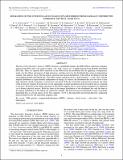SEPARATION OF THE INTERSTELLAR BOUNDARY EXPLORER RIBBON FROM GLOBALLY DISTRIBUTED ENERGETIC NEUTRAL ATOM FLUX
Author(s)
Schwadron, N. A.; Allegrini, F.; Bzowski, M.; Christian, E. R.; Dayeh, M. A.; DeMajistre, R.; Frisch, P.; Funsten, H. O.; Fuselier, S. A.; Goodrich, K.; Gruntman, M.; Janzen, Paul H.; Kucharek, Harald; Livadiotis, G.; McComas, David J.; Mobius, Eberhard; Prested, C.; Reisenfeld, D.; Reno, M.; Roelof, E.; Siegel, J.; Vanderspek, R.; Crew, Geoffrey B.; ... Show more Show less
DownloadSchwadron-2011-SEPARATION OF THE IN.pdf (8.721Mb)
PUBLISHER_POLICY
Publisher Policy
Article is made available in accordance with the publisher's policy and may be subject to US copyright law. Please refer to the publisher's site for terms of use.
Terms of use
Metadata
Show full item recordAbstract
The Interstellar Boundary Explorer (IBEX) observes a remarkable feature, the IBEX ribbon, which has energetic neutral atom (ENA) flux over a narrow region ~20° wide, a factor of 2-3 higher than the more globally distributed ENA flux. Here, we separate ENA emissions in the ribbon from the distributed flux by applying a transparency mask over the ribbon and regions of high emissions, and then solve for the distributed flux using an interpolation scheme. Our analysis shows that the energy spectrum and spatial distribution of the ribbon are distinct from the surrounding globally distributed flux. The ribbon energy spectrum shows a knee between ~1 and 4 keV, and the angular distribution is approximately independent of energy. In contrast, the distributed flux does not show a clear knee and more closely conforms to a power law over much of the sky. Consistent with previous analyses, the slope of the power law steepens from the nose to tail, suggesting a weaker termination shock toward the tail as compared to the nose. The knee in the energy spectrum of the ribbon suggests that its source plasma population is generated via a distinct physical process. Both the slope in the energy distribution of the distributed flux and the knee in the energy distribution of the ribbon are ordered by latitude. The heliotail may be identified in maps of globally distributed flux as a broad region of low flux centered ~44°W of the interstellar downwind direction, suggesting heliotail deflection by the interstellar magnetic field.
Date issued
2011-03Department
Haystack ObservatoryJournal
Astrophysical Journal
Publisher
IOP Publishing
Citation
Schwadron, N. A., F. Allegrini, M. Bzowski, E. R. Christian, G. B. Crew, M. Dayeh, R. DeMajistre, et al. “ SEPARATION OF THE INTERSTELLAR BOUNDARY EXPLORER RIBBON FROM GLOBALLY DISTRIBUTED ENERGETIC NEUTRAL ATOM FLUX .” The Astrophysical Journal 731, no. 1 (March 23, 2011): 56. © 2011 The American Astronomical Society
Version: Final published version
ISSN
0004-637X
1538-4357